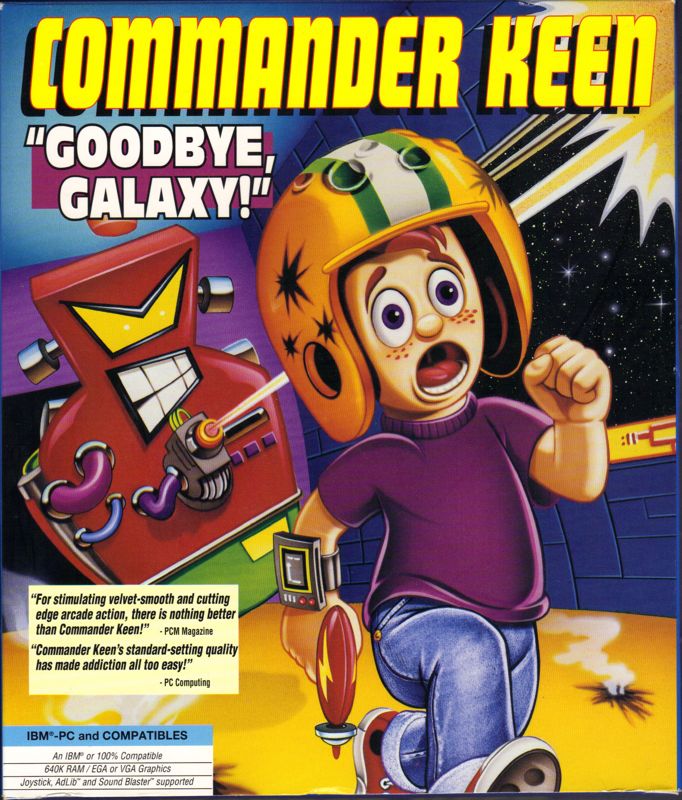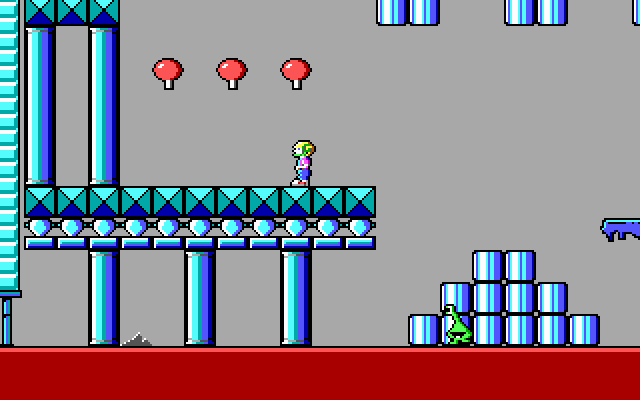Commander Keen is a series of
side-scrolling platform video games developed primarily by
id Software. The series consists of six main episodes, a "lost" episode, and a final game; all but the final game were originally released for
MS-DOS in 1990 and 1991, while the 2001
Commander Keen was released for the
Game Boy Color. The series follows the eponymous Commander Keen, the secret identity of the eight-year-old genius Billy Blaze, as he defends the Earth and the galaxy from alien threats with his homemade spaceship,
rayguns, and
pogo stick. The first three episodes were developed by Ideas from the Deep, the precursor to id, and published by
Apogee Software as the
shareware title
Commander Keen in Invasion of the Vorticons; the "lost" episode 3.5
Commander Keen in Keen Dreams was developed by id and published as a retail title by
Softdisk; episodes four and five were released by Apogee as the shareware
Commander Keen in Goodbye, Galaxy; and the simultaneously developed episode six was published in retail by
FormGen as
Commander Keen in Aliens Ate My Babysitter. Ten years later, a homage and sequel to the series was developed by David A. Palmer Productions and published by
Activision as
Commander Keen. Another game was announced in 2019 as under development by ZeniMax Online Studios.
Invasion of the Vorticons was the only game developed by Ideas from the Deep, and was based on programmer
John Carmack's creation of
adaptive tile refresh, a technique that allowed
IBM-compatible general-purpose computers to replicate the smooth scrolling of
video game consoles such as the
Nintendo Entertainment System. The game's success caused designer
Tom Hall, programmers John Carmack and
John Romero, and artist
Adrian Carmack to found id Software. Their obligations to Softdisk, where they had worked during development of the game, led to the creation of
Keen Dreams as a prototype for the second trilogy of episodes. The final episode was split off during development into a stand-alone retail title, and plans for a third trilogy were cancelled after the success of
Wolfenstein 3D (1992) and development focus on 3D
first-person shooterssuch as
Doom (1993). The final
Keen game ten years later had oversight but little development work from id.
Critical reception and the series' legacy has focused on the two main trilogies of episodes, with
Vorticons having large success as a shareware game and impacting the success of Apogee (now 3D Realms) and its shareware model. The second trilogy sold fewer copies, which was blamed by id and Apogee on its split into two parts, and the 2001 game received mixed reviews. The MS-DOS games have been re-released in several compilation packages, and all but the sixth episode are still sold through modern emulation releases on platforms such as
Steam. References to the series have been made by dozens of other games, especially to the Dopefish, an enemy in the fourth episode, which has been termed one of the
video game industry's biggest
in-jokes. An active
modding community has grown around the series, producing editing tools and unofficial sequels.
All of the games in the
Commander Keen series are side-scrolling platform video games: the majority of the game features the player-controlled Commander Keen viewed from the side while moving on a two-dimensional plane. The player can move left and right and can jump; in every episode besides
Keen Dreams they can also use a
pogo stick to bounce continuously and jump higher than they can normally with the correct timing. The levels are composed of platforms on which Keen can stand, and some platforms allow Keen to jump up through them from below. Beginning with episode two, "The Earth Explodes", there are also moving platforms as well as switches which extend bridges over gaps in the floor.
[19] Keen Dreams and later games add
fireman's poles that Keen can climb up or down, and with the exception of the 2001
Commander Keen also show the platforms viewed from slightly above so as to give a pseudo-3D effect.
[7] Throughout the series, once entered, the only way to exit a level is to reach the end, though for
Keen Dreams and episodes four through six the player can save and return to the middle of a level, rather than only between levels like the other games. In between levels the player travels on a two-dimensional map, viewed from above; from the map the player can enter levels by approaching the entrance.
[20][21] Some levels are optional and can be bypassed, while others are secret and can only be reached by following specific procedures.
[16]
The episodes all contain a different set of enemies in their levels, which the player must kill, stun, or avoid. These enemies are typically aliens or robots. Levels can also include hazards, such as electricity or spikes; touching a hazard or most enemies causes Keen to lose a
life, and the game is ended if all of Keen's lives are lost.
[19] Invasion of the Vorticons features a
raygun that Keen can use ammo for to kill enemies;
[22] Keen Dreams exchanges this for flower power pellets that temporarily stun enemies when thrown,
[21] episodes four through six use a stun gun that permanently stuns enemies,
[23] and the 2001
Commander Keen has a stun gun that temporarily stuns enemies unless they are then killed with a pogo jump.
[24] The player can also find food items throughout the levels which grant points, with an extra life awarded with enough points. There are also colored keycards which grant access to locked parts of levels, collectable items that award an extra life beginning with episode four, and items that grant an instant extra life.
[22]





